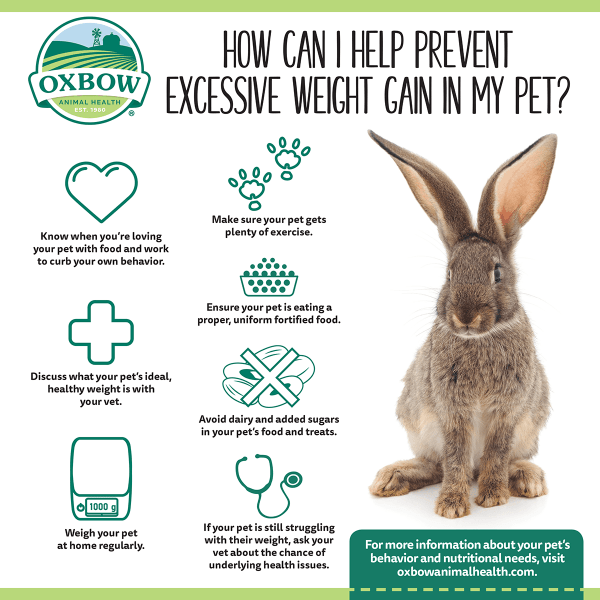Pets naturally gain and lose weight due to many factors like age, activity level, time of year, and health status. While weight gain is not always in itself a bad thing, the underlying factors that can cause excessive weight gain, or obesity, need to be understood, as they can lead to secondary health issues such as diabetes and skin disease, or worsen naturally-occurring, age-related diseases like arthritis and degenerative joint disease. In observance of Pet Obesity Awareness Day, here are some tips and tricks to help your small animal maintain a healthy weight:
Know when you’re loving your pet with food and work to curb your own behavior.
Some pet owners might feel guilty they’re not spending enough time with their pet and can repeatedly compensate for this offering a little extra food or a few extra treats here and there without realizing how many extra calories they are providing to their pet. Your pet values your attention more than they value food (even if they have you convinced otherwise!)—instead of additional food, reward your pet with attention every chance you get.
Just because your pet is begging doesn’t mean they’re starving!
We’re all guilty of giving in to our pets when they beg for food, but it’s important to remember that the immediate food reward we give our pets can have negative effects to their long-term physical wellbeing. Giving in to begging also sets unreasonable expectations for future interactions. Pet owners should actively balance what kinds and amounts of food their pet receives, as pets might still seek out food to eat even though they aren’t particularly hungry.
Make sure your pet gets plenty of exercise.
Just like us, your pet’s ancestors didn’t live a sedentary lifestyle. While we might be long-removed from our ancestors, we still inherit our metabolism and need for a healthy amount of exercise. Encouraging natural behaviors through safe enrichment options such as natural chews can help get your small animal engaged in their surroundings. Make sure to also set aside time each day for your pet to explore outside their habitat in a pet-proofed space, such as an exercise pen. Depending on where you live and the time of year, supervised outside time can also provide an excellent opportunity for physical activity.
Ensure your pet is eating a proper, uniform fortified food.
Specifically avoid muesli mixes that encourage selective eating, as your small animal will try to choose more tasty morsels over healthier pieces of food in mixes, which can lead to imbalanced nutrition. Choose instead a uniform food where the same nutrition can be found in every bite. Also make sure your pet’s food is appropriate for your pet’s species, and that the ingredients are appropriate for your pet’s age. For herbivores like rabbits and guinea pigs, alfalfa-based pellets should only be given to young, pregnant, or nursing animals; adult animals who are not pregnant or nursing should receive a grass hay-based fortified food, such as timothy grass hay.
Avoid dairy and added sugars in your pet’s food and treats.
Dairy-based treats, such as yogurt drops, are unhealthy for small animals like rabbits and guinea pigs and should be avoided completely. They often contain both natural and added sugars to make them appealing to your little one. While the occasional seed can be a nice treat for omnivores like rats, hamsters, and gerbils, these energy-dense foods can also be high in fat and cause weight problems if given too often. The best treat options are hay-based treats like Oxbow’s Simple Rewards baked treats, freeze-dried fruit without any added sugars like Oxbow’s Simple Rewards freeze-dried strawberry or banana treats, or controlled amounts of dark leafy greens.
Moderate your pet’s fruit intake.
While fresh fruits in small, infrequent amounts can certainly be nutritious and enriching, too much fruit can provide an excessive amount of sugars, which can lead to GI disturbances.
Discuss what your pet’s ideal, healthy weight is with your vet.
Some pet owners can have a skewed perception of what a healthy animal looks like. At your pet’s next veterinary appointment, make sure to discuss what your pet’s ideal weight is, and make a plan with your veterinarian about how to get to and maintain this ideal weight.
Weigh your pet at home regularly.
Weight is a physical factor that pet parents can easily monitor at home. Purchase a scale for your pet’s weekly weigh-ins to monitor their weight. The type of scale you should purchase depends on your pet’s species and breed (guinea pigs can often be weighed on a kitchen scale that registers up to 10 pounds, for example). We recommend weighing your pet at the same time of day once a week (i.e. 9 a.m. every Saturday), and keeping a physical log of your pet’s weight each week. This is the most effective way to see if your pet is consistently gaining, losing, or maintaining their weight. While owners should always make note of weight changes, these changes aren’t always something to be concerned about. If your pet is having rapid weight fluctuations, schedule an appointment with your veterinarian as soon as possible.
If you’re following these steps and your pet is still struggling with their weight, explore the possibility of underlying health issues. Sometimes weight gain can be a symptom of health issues that are not as readily visible, such as osteoarthritis and metabolic or thyroid problems. Investigating these issues with your veterinarian can help ensure that your pet lives as healthy and happy of a life as possible.

